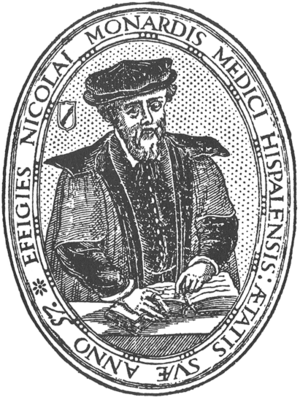Nicolás Monardes facts for kids
Nicolás Bautista Monardes (born in 1493 – died October 10, 1588) was a Spanish physician and botanist. He was famous for studying plants and medicines that came from the New World (the Americas).
Monardes wrote several important books. In his book Diálogo llamado pharmacodilosis (1536), he explored humanism and suggested studying old Greek and Roman writers, especially Pedanius Dioscorides. He also wrote about the importance of Greek and Arab medicine in De Secanda Vena in pleuriti Inter Grecos et Arabes Concordia (1539).
Another book, De Rosa et partibus eius (1540), was about roses and citrus fruits. Monardes also believed that smoking tobacco could cure many illnesses.
His most important work was Historia medicinal de las cosas que se traen de nuestras Indias Occidentales. This book was published in three parts between 1565 and 1574. It was later translated into Latin by Charles de l'Écluse and into English by John Frampton with the title "Joyfull Newes out of the newfound world."
Contents
About Nicolás Monardes
Nicolás Monardes was born in Seville, Spanish Empire in 1493. His father, Nicoloso di Monardis, was an Italian bookseller, and his mother, Ana de Alfaro, was the daughter of a doctor.
Nicolás Monardes studied art and then medicine, getting his degree in medicine in 1533. He started working as a doctor in Seville that same year. Later, he earned his doctorate in medicine from the University of Alcalá de Henares in 1547.
He married Catalina Morales, whose father was also a professor of medicine in Seville. Having doctors on both sides of his family helped Monardes become a well-known physician in Seville for about fifty years. This important position allowed him to publish medical books and get involved in trade with the American colonies.
Monardes and Catalina had seven children. Some of his children traveled to the Americas, but Monardes himself did not. He learned about new American plants and medicines by talking to people who came back from the Americas at the Seville docks. Nicolás Monardes passed away in 1588.
Monardes' Work and Discoveries
Monardes wrote books and reports that showed his ideas about medicine, especially focusing on personal experience. He believed in observing things carefully, testing practices, and updating old medical traditions.
While in Seville, he wrote about many new medicines and plants arriving from the New World. He gathered information from soldiers, merchants, priests, government officials, and women who had traveled there. Many of Monardes’ books were translated into English, including John Frampton's translation of his book on medicines in 1577.
Some people believe that Monardes' work even inspired King Philip II of Spain to send Francisco Hernández de Toledo on an important trip to the New World to study plants. Like other scientists of his time, Monardes' ideas were often discussed and sometimes tested. For example, to see if tobacco really was a counter-poison as Monardes claimed, King Philip II ordered one of his court doctors to try it on a poisoned dog. According to Monardes, the dog was saved.
Monardes and Tobacco
One of Monardes’ most famous beliefs was his strong interest in the tobacco plant. He was so fascinated by it that he thought it had amazing healing powers. Monardes claimed that tobacco could cure more than twenty different conditions, including the common cold and even cancer.
For some time, tobacco was used as a medicine in Europe. Many European doctors believed it was important for cures and for overall health. However, as people used tobacco for a long time, they started to see its harmful effects. Because of this, tobacco was eventually stopped as a main European medicine.
Important Medical Books
Monardes wrote his first four books between 1536 and 1545. His very first book, about pharmacodilosis, was published in 1536. In this book, he defended older medical traditions against Arab medical ideas. His second book, from 1539, was about blood-letting for certain illnesses. In 1545, he published a book on the medical uses of roses and an updated version of an old medical book by Juan de Aviñón.
After these first books, Monardes did not publish anything for twenty years. During this time, he focused on the medicinal products coming from the Americas. This shift led to his most important work, the Historia medicinal de las cosas que se traen de nuestras Indias Occidentales que sirven al uso de la medicina. This book was published in Seville in three parts.
- Part I (1565) focused on resins, purgatives (medicines that help digestion), and Peruvian balsam. It explained how these products were used in medicine.
- Part II (1571) added nearly a dozen more medicinal products. These included things from animals like armadillos, sharks, and caymans. This part also had a long study on tobacco and chapters on sassafras and other plants.
- Part III (1574) went into more detail about the products from the first two parts and added a few new ones, like the bezoar stones.
The complete work was re-released in 1580 and was the final version published during Monardes’ life. The Historia medicinal was very successful because it was published at the right time, was believable, showed Monardes' experience, and was well-written.
Legacy
The plant group Monarda was named after him to honor his contributions to botany.
See also
 In Spanish: Nicolás Monardes para niños
In Spanish: Nicolás Monardes para niños


